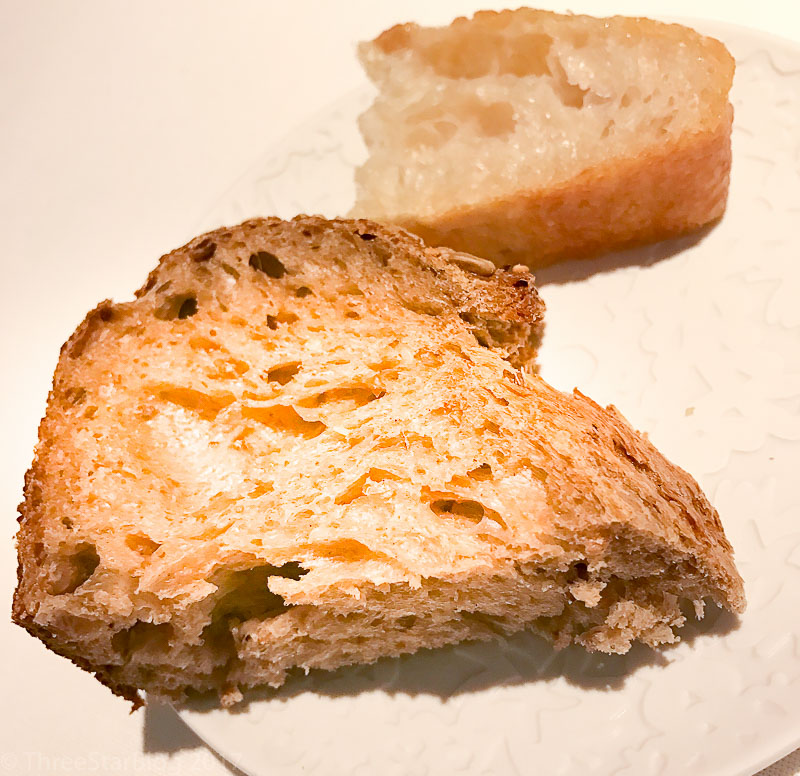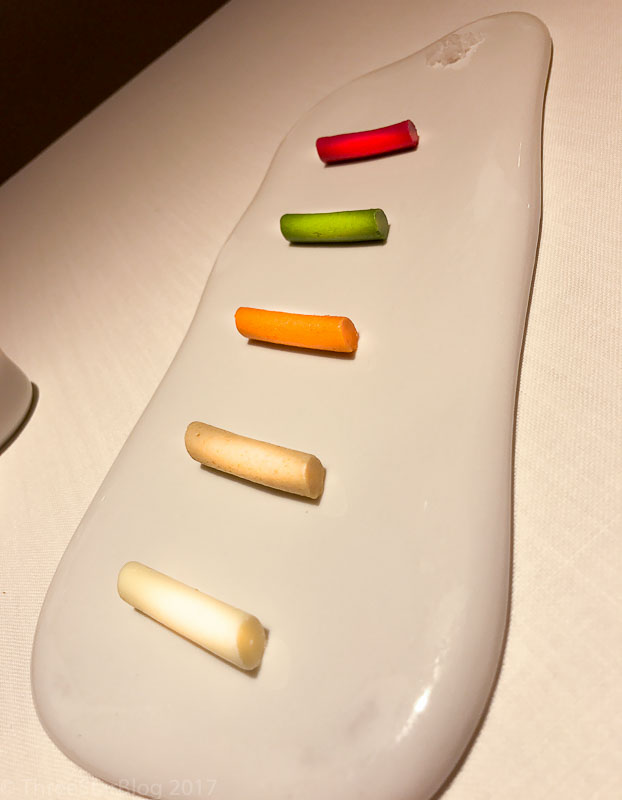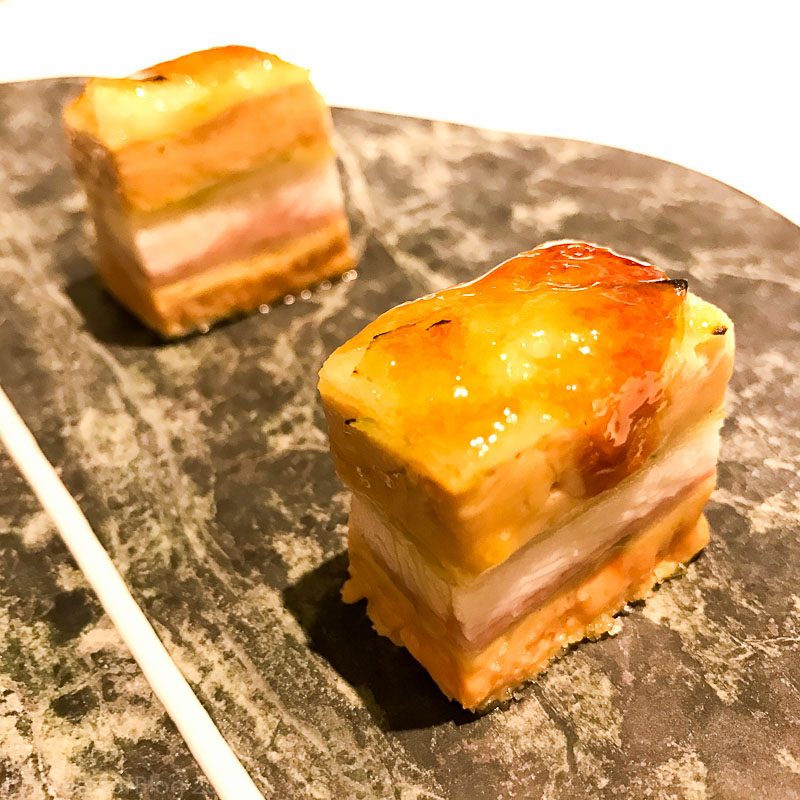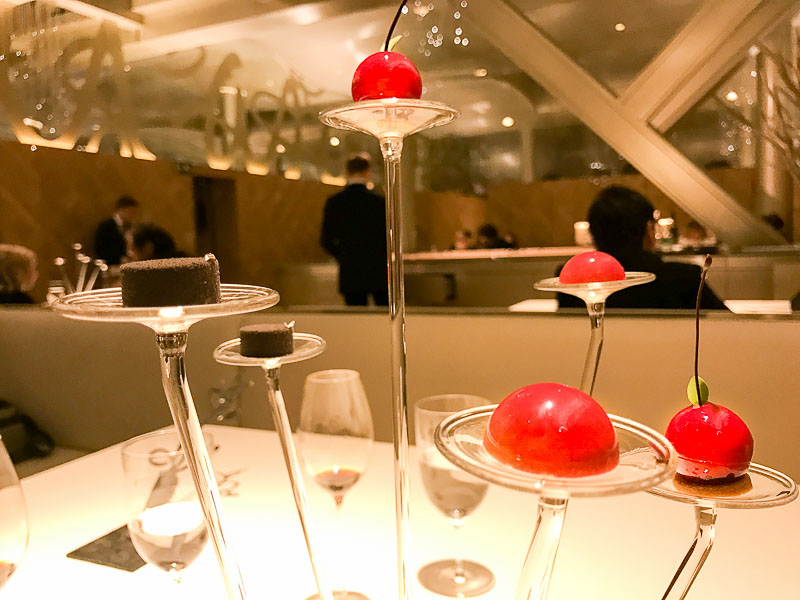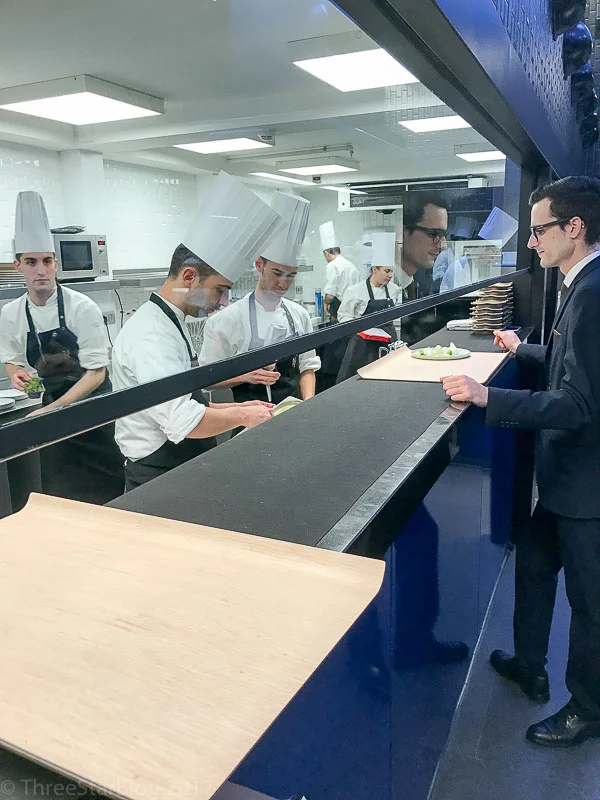Martín Berasategui is to Spanish cuisine what Gordon Ramsay is to American/British fine dining, or Massimo Bottura is to Italian. A semi-celebrity with many restaurants across Europe, Mexico, and the Caribbean and backed by a large brand apparatus, Martín's aspirations to become a global chef are clear. Berasategui's flagship in San Sebastián is one of my favorite restaurants of all time, so my hopes in visiting his Barcelona expansion were high.
My strongest impression of this place was that of the unambiguously formal and distant, replete with suits and ties, soft piano music, stone faces, and terse, disinterested course summaries. Especially compared with the warm, almost theatrically open experiences at DiverXO and Qique Dacosta nearby in Spain, this place was memorably cold. Some of the brilliance of Martín's culinary work made it here, but not all of it.
Martín Berasategui's lieutenant Paolo Casagrande serves as Chef de Cuisine, with Joan Carles Ibáñez managing the front of the house, Antonio Coelho as Maitre'D, and Marc Pinto managing the wine program. The concept for the restaurant was a hybrid of Martín's San Sebastián classics with the innovative approaches found in Barcelona. The name itself, Lasarte, is the suburb of San Sebastián where Martín's main restaurant sits.
BARCELONA, SPAIN
SERVICE: 6.0/10
FOOD: 8.0/10
PRICE PAID: $310PP (INCL. WATER, WINE, TAX, TIP- PRE-CHALLENGE)
VALUE/MONEY: 7.0/10
FINAL RATING: 7.0/10
We are greeted and seated immediately; the restaurant uses a very standard host-stand layout, with big spotlit tables and high ceilings yielding an open and airy feel. Heavy ceramic chargers weigh the table down, and every linen is so crisp you can virtually guarantee that it was ironed only moments before we sat.
The sense of formality is heightened by the extensive use of neutral-to-bright whites (leftmost photo above), just like in San Sebastián, with the difference that the San Sebastián dining room made much wider use of warm-colored wood, flowers, and other organic materials. As you can see in the photo right above, especially with the introduction of natural light, the flagship restaurant has a much more open, welcoming feel. The Barcelona dining room feels like they wanted to notch up the elegance level, and may have lost a bit of charm in the process.
As an aperitif, we are offered glasses of Marques de Gelida's Brut Nature (brut nature meaning very low added sugar) Gran Reserva (aged at least 24 months in oak) cava. Grown in the Catalonia region in an area called Penedès, this particular bottle is a special edition called "4 Heretats." Brut nature sparkling whites are some of my favorite starter beverages, and this one is no exception; crisp and clean, with a nice mineral note and strong green apple and kiwi. The structure is comfortable; medium acidity, medium alcohol, medium minus body, and strong effervesence. It retails for around 15 euros, so I was a little disappointed that the restaurant charges twenty per glass.
It seems a little pedantic to discuss at length, (especially after criticizing the presence of a water menu in a recent review 😳) but we also selected a really interesting sparkling water to accompany our meal, also from the Catalonia region. Sant Aniol sources from a spring near Garrotxa that yields highly volcanic water which is also low in sodium, and it tastes extremely crisp and refreshing. I wish we could get it in the States!
After selecting our beverages, we were brought the evening's menus. On offer were:
- The 7-Course Lasarte Menu, €185, which was described as the classic menu of the restaurant that focuses on Berasategui's legendary dishes.
- The 12-course Tasting Menu, €210, which is a much grander exploration of the classics as well as some innovative new ideas mostly developed by the team at this outpost restaurant.
- An à la carte menu divided by Starters (€34-€41), Fish (€49-58), Meat (€53-€70), and Desserts (€25-€34). Unless you're barely hungry, the set menus are a way better deal; they are priced average-to-low by global standards.
Lasarte's Wine list was a bit short, but had a nice focus on rare and high-end wines that enthusiasts would really enjoy, especially from Burgundy. For example, a 2012 Domaine Roulot Clos des Bouchères Meursault, which retails for around $300 back home, was available for €280. Roulot is described as perhaps the best (or at least most classical) Meursault producer.
An especially photogenic bread cart was wheeled around prior to the start of service, and we were offered many local varieties to start with.
First bites included some brightly-colored crisps of caviar crackers with spicy, curry-flavored curly fries. The fries had a really nice, hot kick on the finish but the caviar crackers' flavor was actually a bit bland. 7/10.
Next, some topinambur (AKA Jerusalem Artichoke, a root from the sunflower family) and pork are served on a small white pedestal. A tiny dollop of sauce on top adds richness and the overall flavor profile lands somewhere in the pork dim sum neighborhood. 8/10.
This is one of my favorite elements of Berasategui's flourish—five small tubes of butter arrive. Each one is a different flavor; regular, mushroom, tomato, spinach, and beetroot. 10/10, the regular is deliciously salty, and the bright-green spinach tastes like deep leafy greens.
Another borrow from the main restaurant, and happily so because this is one of the best individual plates of food that I have ever experienced in fine dining. Foie gras cubes, which are comprised of foie, green apple, and a caramelized crunchy layer on top that contrasts the richer layers underneath. The combination of flavors and textures is like a firework going off inside your head. You'll want to eat 20 of these. At least, I did. 10/10.
Next, as a lead-in to the main menu, a small palate cleanser of cucumber, avocado, and jalapeño. The mousse is quite spicy, with a loose foamy texture. There is a small quantity of razor clam at the bottom, which is fresh and neutral and adds texture but doesn't contribute a ton to the flavor. 8/10, leaves a long spicy aftertaste. Simple and satisfying.
We kick off the main menu with a delicious glass-dish plating of scallops, cauliflower, and quail egg.
The "Queen scallops" (a smallish variety) are so fresh and light that it seems improbable they were harvested more than a few hours earlier even though they came from the English Channel. The cauliflower flavor is strong and pairs with light sweet scallops perfectly. Quail egg yolk pops open as you eat; rich, golden yellow, and delicious. 9/10. On top, a small sponge cake made of black garlic. The foam is made of cauliflower.
Wine service for this course was a really well-selected glass of mainly Sauvignon Blanc white blend from 2016 made by Elvi wines. Elvi is one of the world's oldest kosher vineyards, in business since 1492. Their website also looks like it's from 1492.
Produced in the Alella region, a protected Denominación de Origen (DO) around Barcelona, this lovely white blend most closely resembles a Sauvignon Blanc but includes some Pansa Blanca, also known as Xarel-lo, and most commonly used in the production of Cava. The wine is crisp, dry, and quite floral for a sauv blanc mix with relatively high acid and booze. It's a thoughtful pairing for the airy, foamy dish.
A quick service side note: the first wine glasses we were brought had huge smudges on them. Maybe just because he was embarrassed, but the server reacted to my feedback as though I had actually flipped the table over in front of all the guests. Pure horror, recoil, rush to get more, replace them wordlessly.
Next, an extraordinarily indulgent plating of crayfish with a super-turbo-heavy cream made of beef broth and foam of lemon. I asked what kind of flower was up top, and pretty typical of service the response I got was: "just a normal regular flower." Cool, thanks man.
The core conceit here is the extremely light, sweet crayfish contrasted against the unbelievably heavy cream sauce. It's certainly a contrast.
The restaurant paired this with a lovely Sauvignon Blanc/Semillon blend from Costers Del Segre from 2014. A cult wine grown by famous winemaker Raül Bobet at an altitude of around 1,000 meters, the winemaking was done both in new French oak as well as in some ancient stone lagars he found in the ground when he bought the vineyard. Really interesting techniques that yield a super mineral, crisp, citrus and driven wine with a pretty dense animal-y/sweaty nose, which isn't for everyone. A decent pairing but more likely an excuse to insert an interesting wine into the program.
An exceedingly rich plating of Iberian Presa (ham) tartare served with foie gras curd, oyster, and tomato. Service's recommendation was "to roll it up." The oyster flavor winds up being more dominant than you might expect. Everything's so soft that the feeling is like biting into a super-soft taco with a shell made of ham tartare, which is exactly as iffy a scenario as it sounds. 6/10.
Next, a much more attractive dish of wild sea bass with mantis shrimp, vegetables, snails, mayonnaise, and truffles. This is accompanied by yet more flowers, and I wisely don't bother inquiring what kind. The kitchen really ripped it out on this one; the textures and flavors are close to perfect; light and flaky, perfectly fresh, and perfectly cooked. The sea bass goes great with everything on the dish. 10/10.
The wine service paired this dish with a 2011 Rioja Reserva called Digma made by Castillo De Sajazarra. Made exclusively from tempranillo and with the classic heavily-oaked profile typical of the Rioja region, (in this case 18 months in French) it has a strong spice and black fruit characteristic that comes close to overpowering the fish itself but works much better with the medley of other ingredients on the plate.
And finally, on to the main course of wild hare; an atypical finale. Accompanied by very dense and very filling foie gras (for what feels like the hundredth time, I might add) and a thick, gorgeous layer of black truffle. Though pretty to look at, the truffle isn't terribly flavorful and quite dry, unfortunately. The textures all work really well, but altogether this is just a lot to take in. 7/10. The sauce in the dish is made with hare itself.
A risky but interesting pairing with some heavily oxidized Pedro Ximénez Monteagudo Delgado Zuleta. Aged in American Oak and rocking a pretty hefty 17.5% alcohol, this would destroy a less-rich dish than the one presented. It actually pairs more or less perfectly.
Made with delicious verbena, orange jelly, and pearls of lemon, this mandarin orange sorbet is about as incredible a first impression as the pastry kitchen could make. 🍊 9/10.
And finally, the last course of the Lasarte menu. Cocoa, a cream made of fermented black garlic, coffee grounds, raspberry ice cream, and moscovado sugar. 9/10.
A few last petit fours and treats to finish- some cherry with mousse, dark chocolate and sesame, and white chocolate with strawberry, 9/10. Some of the attention to detail I really enjoyed about the flagship restaurant is present; the base of the petit four carrier has "LASARTE" imbued in letters on the glass itself; a nice little touch.
Finally, we ended with a short tour of the kitchen. You won't find a better-capitalized restaurant in Europe.












